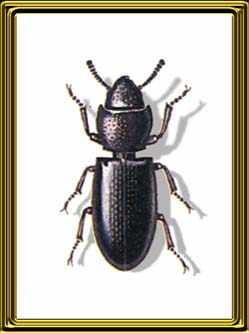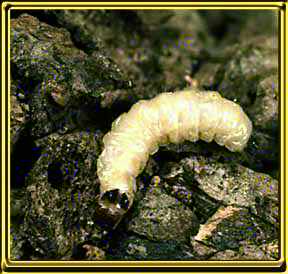
Tenebroides
mauritanicus
(Cadelle Beetle)
(Cadelle Beetle)
When Linnaeus described this insect in 1758, it was in all probability already cosmopolitan. The French called it the "cadelle" (which from the Latin catulus means offspring) and this is the name by which it is commonly known at the present time. It is known also as the "bread beetle" because of its habit of cutting the silk bolting in flour-mill machinery. Hatch (1942) notes in Europe the cadelle lives outdoors under bark and in rotten wood. Here it is predacious on wood-feeding insects.
Originally an African species, this beetle has now spread to all parts of the world. It is found particularly in grain warehouses, silos and mills. The larvae live hidden away, feeding on corn and flour , but also, to a certain extent predating on other insect species.The cadelle is believed by some entomologists to be a native of America, for all species of the family Ostomidae are found in the New World. It is one of the best known of the stored-grain pests, in part because it is also a common "pantry pest" in the house, where adults and larvae feed on cereals, breakfast foods, potatoes, shelled and unshelled nuts, or fruit, and prefer to lay their eggs under the flaps of cartons. They can gnaw through sacks and paper packages and wood, thus allowing other insects access. Unlike the granary and rice weevils, they feed not only on whole grains, but also on flour and a variety of other products, and are therefore much more important as pantry pests.
The cadelle may have been originally a predator under loose bark, as other species of the family are today. It does attack the larvae of other grain-infesting insects, particularly Plodia interpunctella and Oryzaephilus surinamensis. Another peculiarity of this insect is its habit of burrowing into the woodwork of grain bins or other wooden structures, sometimes causing them to collapse. It may remain there for long periods in large numbers, only to emerge and infest the next load of grain. Other grain pests may also hide in its burrows.
Description:
The shiny black adult is elongate, oblong, and flattened, and is one of the largest of the grain-infesting beetles, being about 8 to 9mm long. The prothorax, is distinctly separated from the rest of the body by a loose, prominent joint, the males can be distinguished from the females by the numerous and fine punctures on the ventral side of the abdomen, whereas the punctures on the female are less numerous and coarser.
Life Cycle:
The females lay about 1,000 eggs loosely in flour, grain, or other foodstuff. Although the following experiment was interesting: Bond and Monro (1954) reared the cadelle on oatmeal cultures containing moulds or yeast. They found the female lays her eggs in clusters in the food or packs them in crevices. One female produced a maximum of 3,581 eggs. The eggs, laid in clusters of between 10 to 60 eggs in food materials, hatch in about 10 days. The fleshy, white to greyish-white larva has a black head and a black plate with two horny black projections at the tip of the abdomen (see picture below) and the larvae may reach 3/4 inch in length. The life cycle may be as short as 70 days, but it may be much longer under conditions unfavourable to the insect's development. The females generally live for a year, and have been kept alive for more than 3 years.

The length of the larval period varies with the environment and may extend from 38 to 414 days. The cadelle may undergo from three to seven molts, the average for this insect being four. The larvae and adults are large and can go without food for 52 days (adults) to 120 days (larvae). The larvae feed on a great variety of grains, as well as on flour, meal, biscuits and bread, vegetables, dried fruits, etc. One larva was found capable of destroying the germinating powers of 10,000 grains. The larvae, when attacking such grains as wheat and oats, usually confine themselves to the embryo, this being the softests part. Upon migrating from its food source in order to pupate, it occurs accidentally in such unusual places as books, balls of twine, carpet rolls, rugs and in bottles of milk. The cadelle pupates in from eight to 25 days. In more temperate countries there may be two generations with a partial third. It is believed there are three generations in tropical countries.
These insects are also a serious pest in tobacco factories. Here they occur in bales of dry tobacco where it is claimed they bore into them in search of insect larvae. According to Candura (1943), the young larvae will feed on the tobacco, but will die unless they are able to feed on insects too. The larvae require two to three years to develop in the tobacco which they finally destroy through their borings. The larvae pupate or hibernate by hollowing out a cell in the adjacent wood. Thus, they may remain in the wood or empty bins for months and then emerge to reinfest fresh grain placed in these bins. This woodboring habit of the larvae has resulted in the pupal chamber being excavated in such curious places as the corks of bottles and in books.